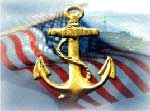 Happy National Maritime Day! The day has been celebrated in the US since 1933. After World War II US flag shipping accounted for over 40% of the world’s total fleet. Currently the US ranks around 10th in the world by number of ships, placing between Indonesia and Hong Kong.
Happy National Maritime Day! The day has been celebrated in the US since 1933. After World War II US flag shipping accounted for over 40% of the world’s total fleet. Currently the US ranks around 10th in the world by number of ships, placing between Indonesia and Hong Kong.
Shell is on its way to building the largest floating offshore facility in the world for its Prelude Floating Liquefied Natural Gas (FLNG) Project in Australia. The FLNG facility will be 488 meters long and will weigh around 600,000 tonnes – roughly six times as much as the largest aircraft carrier. It will be longer longer and heavier than the new Maersk Triple E ships which, when delivered, will be 400 meters long. The FLNG will also be longer than the largest ship ever built, the Seawise Giant/Jahre Viking/Knock Nevis, which was scrapped in 2010. The Knock Nevis was 458 meters long, but did displace more, at 657,019 tonnes, than will the FLNG.
The FLNG will be deployed over the Prelude field located approximately 475 kilometres north-northeast of Broome, Western Australia, and over 200 kilometres from the nearest point on the mainland. The field is too far offshore to use conventional techniques of building gas-compression platforms and long subsea pipelines to shore. Instead, the natural gas will be liquefied on the vessel and loaded onto LNG ships for transport.
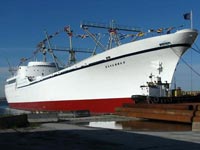
NS Savannah
In the US, National Maritime Day is May 22nd. The day was chosen to commemorate the departure from Savannah, Georgia of the American steamship, SS Savannah, first steamship to cross the Atlantic Ocean, on May 24, 1819. To celebrate National Maritime Day, the Baltimore Port Alliance is hosting tours on the NS Savannah, the first and last US flag nuclear merchant ship.
National Maritime Day 2011 Aboard the N.S. SAVANNAH
Ironically though both ships named Savannah were considered technological break-throughs in their day, neither was a commercial success.
Thanks to Miroslav Antic for passing the article along.
A preview of MaineSail Magazine, the first issue of which will be available for download June 1st, 2011 at www.themainesail.com. Looks beautiful.
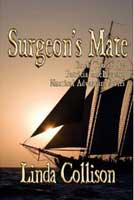 Patrick McPherson is a 19 year surgeon’s mate in the Royal Navy. By all appearances, he is an upstanding young man with a promising future. The dark secret that the young mate carries is that he is indeed, a she. Patrick was born as Patricia. When Patricia’s husband, a ship’s surgeon dies while tending a fever outbreak in the Indies, she decides to “shed Patricia like an inconvenient skin, becoming Patrick McPherson, a surgeon’s mate, of His Majesty’s frigate Richmond, on its undercover mission to Havana…” Linda Collison’s new book Surgeon’s Mate is the second in her series following the nautical adventures of Patricia McPherson. See our review of Collision’s first book of the series, Star Crossed.
Patrick McPherson is a 19 year surgeon’s mate in the Royal Navy. By all appearances, he is an upstanding young man with a promising future. The dark secret that the young mate carries is that he is indeed, a she. Patrick was born as Patricia. When Patricia’s husband, a ship’s surgeon dies while tending a fever outbreak in the Indies, she decides to “shed Patricia like an inconvenient skin, becoming Patrick McPherson, a surgeon’s mate, of His Majesty’s frigate Richmond, on its undercover mission to Havana…” Linda Collison’s new book Surgeon’s Mate is the second in her series following the nautical adventures of Patricia McPherson. See our review of Collision’s first book of the series, Star Crossed.
Continue reading
A recent NOAA survey of the Caribbean off the southern coasts of the U.S. Virgin Islands of St. John and St. Thomas and off eastern Puerto Rico discovered six previously unknown shipwrecks.

Photo: Paul Darrow for The Globe and Mail
There is an old saying about an ax that never wears out so long as you keep replacing the head and the handle. But what happens if you replace the head and handle at the same time? Is it the same ax? Or is it another ax altogether? These are the sorts of question being asked about the “refurbishment” and “repair” of the Bluenose II.
Continue reading
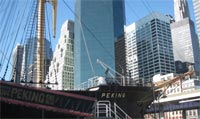 Following up on the previous news that the current board of the financially troubled South Street Seaport Museum is being replaced, that the Attorney General has barred the removal of the museum’s historic ships from New York harbor and that new funding is being arranged, the Save our Seaport grassroots organization is sponsoring a “Rally to Save our Seaport” on Sunday, May 22, at 2PM, on South Street at Pier 16 just below the Peking‘s bowsprit. It will be a great opportunity for friends, supporters and volunteers to show their enthusiasm for the Seaport and its long term survival and future growth.
Following up on the previous news that the current board of the financially troubled South Street Seaport Museum is being replaced, that the Attorney General has barred the removal of the museum’s historic ships from New York harbor and that new funding is being arranged, the Save our Seaport grassroots organization is sponsoring a “Rally to Save our Seaport” on Sunday, May 22, at 2PM, on South Street at Pier 16 just below the Peking‘s bowsprit. It will be a great opportunity for friends, supporters and volunteers to show their enthusiasm for the Seaport and its long term survival and future growth.
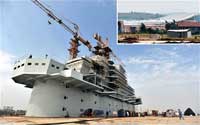 As we posted last week, the US Navy has five times more aircraft carrier flight deck capacity than the rest of the world combined. Nevertheless the Chinese have leapt ahead in the construction of a concrete air craft carrier on a government building roof top. What strategic advantage that might provide remains unclear.
As we posted last week, the US Navy has five times more aircraft carrier flight deck capacity than the rest of the world combined. Nevertheless the Chinese have leapt ahead in the construction of a concrete air craft carrier on a government building roof top. What strategic advantage that might provide remains unclear.
Concrete evidence of China’s naval ambitions
Continue reading
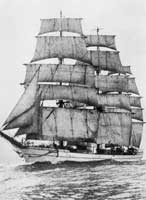
Tusitala
On May 25th, in addition to other items in their collection, the Seaman’s Church Institute is auctioning off a letter written by Joseph Conrad in 1923 to the “owners and ship’s company of the Tusitala, ” in which he sends “my brotherly good wishes for fair winds and clear skies on all their voyages. And may they be many!” (Thanks to Joan Druett, author of Tupaia: Captain Cook’s Polynesian Navigator, for posting about the auction on her blog.)
But who were the “owners and ship’s company of the Tusitala” to whom Conrad passed on his best wishes? Therein lies a tale. Continue reading

Photo: Flip Nicklin/Minden/FLPA
Roughly a year ago I went skin diving with dolphins in Honduras. We were told that the dolphins liked to play catch with eel grass. I dove to the bottom, pulled up a handful of eel grass and held it out in front of me. A dolphin would swim up and I would put some eel grass in its mouth. The dolphin would spit it out and I would grab it and we would start the game again. It was hard to tell if I was playing with the dolphin or the dolphin was playing with me. I would have loved to be able to communicate with these fascinating creatures. Now scientists may have developed computers that will allow divers to communicate directly with dolphins for the first time.
Talk with a dolphin via underwater translation machine
Continue reading
Last week we posted about the upcoming first William Main Doerflinger Memorial Shanty Session to be held at the Noble Maritime Collection at Snug Harbor. The shanty sing was well attended and the space was beautiful as well as historic. The accoustics were quite good as well. I was fortunate enough to be able to attend, to sing along and to shoot a bit of video. Here is a short clip.
 Mickey Mouse now apparently owns SEAL Team 6, or at least the name. Disney has filed three trademark applications to to claim the rights to the phrase “SEAL Team 6.” SEAL Team 6 is believed to be the Navy commando squad that killed Osama Bin Laden in the recent raid on his compound. How can Disney copyright the term “SEAL Team 6?” “Officially, the team’s name is classified and not available to the public, technically there is no team 6.”
Mickey Mouse now apparently owns SEAL Team 6, or at least the name. Disney has filed three trademark applications to to claim the rights to the phrase “SEAL Team 6.” SEAL Team 6 is believed to be the Navy commando squad that killed Osama Bin Laden in the recent raid on his compound. How can Disney copyright the term “SEAL Team 6?” “Officially, the team’s name is classified and not available to the public, technically there is no team 6.”
That is no longer the case. It is now a trademark of the Walt Disney Company.
Disney Trademarks ‘Seal Team 6,’ Name Of Unit That Killed Bin Laden
Continue reading

Photo: DNAinfo/Julie Shapiro
Great news for supporters of New York’s South Street Seaport Museum which has been in a state of near collapse since February. The Save our Seaport grassroots organization reports the following:
The NYS Attorney General has told the Seaport Museum New York that all vessels must remain where they are. This effectively blocks the Museum’s efforts to remove them from New York Harbor. Whether they can stay at the Seaport is not known at this time. But staying in New York allows them to be looked after in a better manner.
Continue reading
The SBX-1 , the Sea Based X-Band Radar 1, looks like something out of science fiction. It recently arrived at Vigor Shipyard on Seattle’s Harbor Island for three months of maintenance and upgrading.
The SBX-1 is a huge white dome with a half dozen or so smaller domes ontop of a modified MODU, a Mobile Offshore Drilling unit, on which high tech radar arrays have replaced the drilling rig. It is 240 feet wide, 390 feet long, and 280 feet high from its keel to the top of the radar dome (radome) and can cross an ocean under its own power at eight knots.
Massive radar could track baseball from across a continent
Continue reading
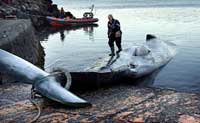 Time recently posted an article “Why Fukushima Is Good for Whales (in Iceland).” The article, in fact, had almost nothing to do with the damaged nuclear power plants at Fukushima (at least as applied to whales) and quite a lot to do with the damage done by the tsunami. Iceland exports the meat of endangered fin whales to Japan. Tsunami damage to whale processing plants in Japan may delay the start of the Icelandic whaling season. The Time article reports that the Icelandic whaling season has been “called off” while other sources say that it has been postponed or delayed.
Time recently posted an article “Why Fukushima Is Good for Whales (in Iceland).” The article, in fact, had almost nothing to do with the damaged nuclear power plants at Fukushima (at least as applied to whales) and quite a lot to do with the damage done by the tsunami. Iceland exports the meat of endangered fin whales to Japan. Tsunami damage to whale processing plants in Japan may delay the start of the Icelandic whaling season. The Time article reports that the Icelandic whaling season has been “called off” while other sources say that it has been postponed or delayed.
Continue reading
 How can you tell when you have too many aircraft carriers? Possibly, when you start using this expensive hardware for sporting venues.
How can you tell when you have too many aircraft carriers? Possibly, when you start using this expensive hardware for sporting venues.
On Nov. 11, 2011, the Veteran’s Day Carrier Classic basketball game between North Carolina and Michigan State will be played on an aircraft carrier in San Diego harbor. Either the USS Ronald Reagan or the USS Carl Vinson is expected to host the first ever collegiate basketball game on a warship. The USS Carl Vinson was recently in the news as the ship from which Osama bin Laden was buried at sea.
Carrier Classic could be played on ship that buried bin Laden at sea
Continue reading
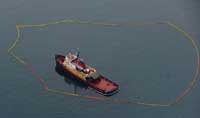 On March 24, 1989 the third mate on the Exxon Valdez lost track of the ship’s position and ran the ship into Bligh Reef in Prince William Sound, Alaska, resulting in a spill of roughly 40,000 tons of crude oil, the largest offshore spill in the US prior to last year’s Deepwater Horizon explosion and spill.
On March 24, 1989 the third mate on the Exxon Valdez lost track of the ship’s position and ran the ship into Bligh Reef in Prince William Sound, Alaska, resulting in a spill of roughly 40,000 tons of crude oil, the largest offshore spill in the US prior to last year’s Deepwater Horizon explosion and spill.
After the Exxon Valdez spill, new safety measures were instituted in Prince William Sound including the addition of tugs to scout for ice. On December 23, 2009 the captain of the Pathfinder, an ice scout tug, lost track the tug’s position and ran aground on Bligh Reef, spilling about 6,400 gallons of diesel fuel. A report from the US Coast Guard’s investigation is due out this week and is reported to blame a lack of crew communication for the grounding.
Twenty year separates the two accidents. The two things they have in common is that Bligh Reef hasn’t moved and that human error is still with us.
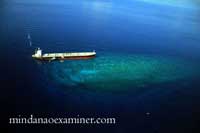 The perhaps poorly named MV Double Prosperity, loaded with 65,000 tons of coal, grounded on Bakud Reef on Sunday in Sarangani Bay in the Philippines.
The perhaps poorly named MV Double Prosperity, loaded with 65,000 tons of coal, grounded on Bakud Reef on Sunday in Sarangani Bay in the Philippines.
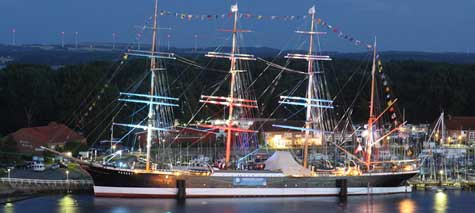
Today through Sunday, there will be a 100th birthday party in Travemünde, Germany, for one of the last of the true windjammers, the four masted barque Passat. One of the F. Laeisz Flying P-Liners, she was in launched 1911 at the Blohm & Voss shipyard, Hamburg. She carried commercial cargoes under sail until 1949, rounding Cape Horn 39 times. In 1951, she was converted to a school ship and in 1959 was purchased by the Baltic Sea municipality of Lübeck.
Happy birthday to a grand old ship!

